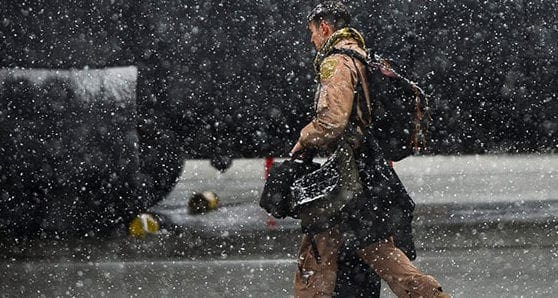 CNN recently hosted a seven-hour climate bore-athon. That climate cataclysms are real and already devastating our planet was not open to discussion. So host Wolf Blitzer and 10 Democrat presidential contenders vied to make the most extravagant claims about how bad things are, and who would spend the most taxpayer money and impose the most Green New Deal rules to restrict our freedoms and transform our energy, economy, agriculture and transportation, in the name of preventing further cataclysms.
CNN recently hosted a seven-hour climate bore-athon. That climate cataclysms are real and already devastating our planet was not open to discussion. So host Wolf Blitzer and 10 Democrat presidential contenders vied to make the most extravagant claims about how bad things are, and who would spend the most taxpayer money and impose the most Green New Deal rules to restrict our freedoms and transform our energy, economy, agriculture and transportation, in the name of preventing further cataclysms.
Cory Booker opened the bidding at $3 trillion. Kamala Harris and Julian Castro raised it to $10 trillion. Bernie Sanders upped it to $16 trillion. Then they got down to the business of telling us which personal choices and living standards they intend to roll back the furthest. Among the proposals:
Ban all commercial air travel (ruling and privileged classes presumably excepted). Change our dietary guidelines or ban beef outright. “Massively” increase taxes. “Make polluters pay” for emitting greenhouse gases. Eliminate onshore drilling, offshore drilling, fracking, coal-fired power plants, internal combustion engines. No new pipelines. In short, ban the fossil fuels that provide 80 per cent of America’s energy! No new nuclear power plants either. And then somehow, amid all that insanity, ensure “climate justice.”
They need to be doused with a few buckets of icy cold reality. The first bucket: We do not face a climate emergency. Computer models certainly predict all kinds of catastrophes. But both the models and the increasingly hysterical assertions of planetary chaos are completely out of touch with reality.
The second, even colder bucket of reality: Wind and sunshine may be free, renewable, sustainable and eco-friendly. But the technologies, lands and raw materials required to harness this widely dispersed, intermittent, weather-dependent energy to benefit humanity absolutely are not. In fact, they cause far more environmental damage than any of the fossil fuel energy sources they would supposedly replace.
Biofuels. U.S. ethanol quotas currently gobble up over 40 per cent of America’s corn – grown on cropland nearly the size of Iowa, to displace about 10 per cent of America’s gasoline. Corn ethanol also requires vast quantities of water, pesticides, fertilizers, natural gas, gasoline and diesel, to produce and transport a fuel that drives up food prices and thus adversely affects food aid and nutrition in poor nations, damages small engines, and gets one-third fewer miles per gallon than gasoline.
Replacing 100 per cent of U.S. gasoline with ethanol would require some 360 million acres of corn. That’s more than twice the land area of Texas. But eliminating fossil fuel production means we’d also have to replace the oil and natural gas feed stocks required for pharmaceuticals, wind turbine blades, solar panel films, paints, synthetic fibers, fertilizers, and plastics for cell phones, computers, eyeglasses, car bodies and countless other products. That would require growing corn on almost four times the area of Texas.
Solar power. Solar panels on Nevada’s Nellis Air Force Base generate a minuscule 15 megawatts of electricity, about 40 per cent of the year, from 72,000 panels on 140 acres. Arizona’s Palo Verde Nuclear Power Plant generates 760 times more electricity, from less land, 90 to 95 per cent of the time.
Generating Palo Verde’s electricity output using Nellis technology would require acreage 10 times larger than Washington, DC. And the solar panels would still provide electricity only 40 per cent of the year.
Generating the 3.9 billion megawatt-hours that Americans consumed in 2018 would mean we would have to completely blanket over 12 million acres – half of Virginia – with solar panels, and get the sun to shine at high-noon summertime Arizona intensity 24/7/365, wherever we install those panels.
Wind power. Mandated, subsidized wind energy likewise requires millions of acres for turbines and new transmission lines, and billions of tons of concrete, steel, copper, rare earth metals and fiberglass.
Like solar panels, wind turbines produce intermittent, unreliable electricity that costs much more than coal, gas or nuclear electricity – once subsidies are removed – and must be backed up by fossil fuel generators that have to go from standby to full-power many times a day, very inefficiently, every time the wind stops blowing. Turbine blades already kill raptors, other birds and bats – perhaps a million or more every year in the U.S. alone. Their light flicker and infrasonic noise impair human health.
Modern coal and gas-fired power plants can generate 600 megawatts some 95 per cent of the time from less than 300 acres. Indiana’s Fowler Ridge wind farm also generates 600 megawatts – from 350 towering turbines, sprawling across more than 50,000 acres (much more than Washington, DC) – less than 30 per cent of the year.
Now let’s suppose we’re going to use wind power to replace those 3.9 billion megawatt-hours of U.S. electricity consumption. Let’s also suppose we’re going to get rid of all those coal and gas-fired backup power plants, natural gas for home heating, coal and natural gas for factories, and gasoline-powered vehicles – and replace them all with wind-powered electricity. We’ll also use wind turbines to generate enough extra electricity every windy day to charge batteries for just seven straight windless days.
That would require a lot of wind turbines, as we are forced to go into lower and lower quality wind locations. Instead of generating full nameplate power maybe one-third of the year, on average, they will do so only around 16 per cent of the year. Instead of the current 58,000 turbines, the U.S. would need some 14 million turbines, each one 400 feet tall, each one capable of generating 1.8 megawatts at full capacity, when the wind is blowing at the proper speed.
Assuming an inadequate 15 acres apiece, those monster turbines would require some 225 million acres! That’s well over twice the land area of California – without including transmission lines! Their bird-butchering blades would wipe out raptors, other birds and bats across vast stretches of America.
But every turbine really needs at least 50 acres of open space, and Fowler Ridge uses 120 acres per turbine. That works out to 750 million acres (10 times Arizona) – to 1,800 million acres (10 times Texas or nearly the entire Lower 48 United States)! Eagles, hawks, falcons, vultures, geese and other high-flying birds and bats would virtually disappear from our skies. Insects and vermin would proliferate.
Manufacturing those wind turbines would require something on the order of four billion tons of steel, copper and alloys for the towers and turbines; eight billion tons of steel and concrete for the foundations; four million tons of rare earth metals for motors, magnets and other components; one billion tons of petroleum-based composites for the nacelle covers and turbine blades; and massive quantities of rock and gravel for millions of miles of access roads to the turbines. Connecting our wind farms and cities with high-voltage transmission lines would require still more raw materials – and more millions of acres.
All these raw materials must be mined, processed, smelted, manufactured into finished products, and shipped all over the world. They would require removing hundreds of billions of tons of earth and rock overburden – and crushing tens of billions of tons of ore – at hundreds of new mines and quarries.
Every step in this entire process would require massive amounts of fossil fuels, because wind turbines and solar panels cannot operate earth moving and mining equipment – or produce consistently high enough heat to melt silica, iron, copper, rare earth or other materials.
Not once did CNN’s hosts or any of the Green New Deal presidential candidates so much as mention any of this. To them, “renewable” energy will just happen – like manna from Gaia or beamed down from the Starship Enterprise.
Paul Driessen is senior policy adviser for the Committee For A Constructive Tomorrow (CFACT) and author of articles and books on energy, environmental and human rights issues. He is also a contributor to the Frontier Centre for Public Policy think-tank.
The views, opinions and positions expressed by columnists and contributors are the author’s alone. They do not inherently or expressly reflect the views, opinions and/or positions of our publication.

